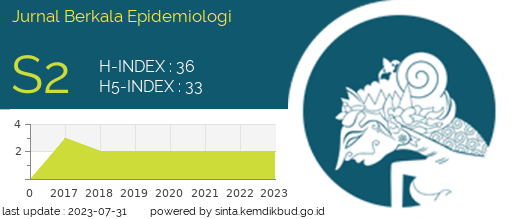Accreditation Number: 79/E/KPT/2023
Guide For Author
GUIDE FOR AUTHOR
JURNAL BERKALA EPIDEMIOLOGI (PERIODIC EPIDEMIOLOGY JOURNAL)
Jurnal Berkala Epidemiologi is a four-monthly journal publishing manuscripts in epidemiology. The manuscript sent to the journal editor is a research paper or a draft of the literature review concept that has not been published elsewhere. The manuscript sent contains the title, name (team) of the author(s), e-mail address(s) (team) of the author(s), correspondence address, and abstract in Indonesian and English. Articles include abstracts, introductions, methods, results, discussion, conclusions, acknowledgment, and references. Manuscripts must have max ten pages with one space. The manuscript uses a Microsoft Word or PDF computer program with Times New Roman font size 11 within an A4 page size and moderate size margin. The title is in English and uses 14 New Times Roman. Indonesian titles use Times New Roman, italics with size 11. The origin of the institution and the e-mail address (team) of the researcher are listed under the English title using 11 Times New Roman. The initial Paragraph protrudes 0.5 inches, with a number of columns 2.
1. GUIDELINE FOR ONLINE SUBMISSION
The author should register as an author and/or offer to be a reviewer via this link. Following submission, authors who submit a manuscript will receive an email confirming receipt, enabling them to track their submission status at any time by logging onto the online submission interface. The submission tracking includes the manuscript review status and the editorial process.
2. GUIDELINES FOR MANUSCRIPT PREPARATION
Type of paper
Contributions falling into the following categories will be considered for publication: Original Articles, Literature Review Articles, and Commentary Articles, which are accepted but have not been submitted and would not be submitted elsewhere.
1. Original Article
Present an original and important major advance in epidemiology having a wide research scheme and deep discussion of the findings. The structure of the article consists of Introduction, Methods, Results and Discussion, Conclusion, Conflict of Interest, Author Contribution, Acknowledgment, and References. This article should be typed within not excess of 10 pages (including figures and tables). This type of article must have passed the ethical clearance.
Abstract
Abstracts are written in Indonesian and English with 4 to 5 keywords. The abstract must be written in 1 (one) paragraph consists of 150-250 words. Abstract consists of background problems (1-2 sentences), research objectives (1 sentence), research methods, and research results. Written format article history keyword, and publisher information, and Times New Roman license size 10.
Background: The background contains the background of the research. It can't contain about variable definition but rather the explanation of why the variable needs to be investigated. It should be described in 1-2 sentences. Purpose: The purpose of this research also should be described in 1 sentence. Methods: The method describes the design or the design of the research, the research target (population, sample and data sources), techniques and data collection instruments and describes the techniques or data analysis procedures. Results: The results can be described like the following example : "This research showed that there was an relationship between variable X (p = 0,000; OR = 45,25; 95% CI = 13,23 < OR < 154,72) and disease Z"”. Conclusion: The conclusion should be described in 1-2 sentence.
Introduction
Introduction consisting of the background of the problem, and identification of problems that focused on the explanation of why the variable needs to be investigated or about research gap and research purposes. The introduction can be described at a maximum of 20% of the total page
Methods
The method used is described in detail. Describing the design or the design of the research, the research target (population, sample and data sources), techniques and data collection instruments and describes the techniques or data analysis procedures.
The method includes the design, population, sample, data sources, techniques/instruments of data collection and data analysis procedures. Methods should make readers be able to reproduce the experiment. Provide sufficient detail to allow the work to be reproduced. The method already published should be indicated by a reference: only relevant modifications should be described. Do not repeat the details of established methods. Include an ethical test result (number, location, and date of ethical test). The methods can be described a maximum 20% of total page
Results
The result contains of the output of the research, it should be clear and concise. The result should describe or summarize the authentic findings, valid, and in accordance with the objectives and methods of research.
Discussion
The discussion contains the interpretation of results, linking the results of research with theories and previous findings are relevant. The discussion is not repeating the results.
Research Limitation (Optional)
It is for sure that your research will have some limitations and it is normal. However, it is critically important for you to be striving to minimize the range of scope of limitations throughout the research process. Also, you need to provide the acknowledgment of your research limitations in the conclusions chapter honestly.
It is always better to identify and acknowledge the shortcomings of your work, rather than to leave them pointed out to you by your dissertation assessor. While discussing your research limitations, don't just provide the list and description of shortcomings of your work. It is also important for you to explain how these limitations have impacted your research findings.
Your research may have multiple limitations, but you need to discuss only those limitations that directly relate to your research problems. For example, if conducting a meta-analysis of the secondary data has not been stated as your research objective, no need to mention it as your research limitation
Conclusion
The conclusion answers the problem and purpose of research. Drawing conclusions, widespread demarcation, and the emergence of a new theory that is well established are more meaningful than superficial conclusions. Conclusions are made in paragraph form not in bulleting or numbering systems. The conclusion is only 1-2 paragraphs
Conflict of Interest
It explains a situation in which a person or organization is involved in multiple interests, financial or otherwise, and serving one interest could involve working against another. Typically, this relates to situations in which the personal interest of an individual or organization might adversely affect a duty owed to make decisions for the benefit of a third party.
Author Contributions (Author>1 person)
It is explained about individual author contributions. All those who meet the authorship criteria are listed as writers, i.e. all authors declare that they are participating actively in research and article writing and partly responsible for the content of writing, including in the preparation and writing of concepts, designs, analysis, or revision of the article. The role(s) of all authors should be listed. Example : ZS: Conceptualization, Methodology, Software PY.: Data curation, Writing- Original draft preparation. WY: Visualization, Investigation. Jan Jansen: Supervision.: AK: Software, Validation.: SQ: Writing- Reviewing and Editing
Acknowledgments
Acknowledgments are primarily addressed to the research funder or donor. Acknowledgments can also be conveyed to those who assist in conducting the research.
2. Literature Review
A literature review is a search and evaluation of the available literature in your given subject or chosen topic area. It documents the state of the art with respect to the subject or topic you are writing about. The structure of the article consists of Introduction, Methods, Results and Discussion, Conclusion, Conflict of Interest, Author Contribution, Acknowledgment, and References. This article should be typed within no excess of 10 pages (including figures and tables). This type of article doesn't require an ethical clearance
Abstract
Abstracts are written in Indonesian and English with 4 to 5 keywords. The abstract must be written in 1 (one) paragraph consists of 150-250 words. Abstract consists of background problems (1-2 sentences), research objectives (1 sentence), research methods, and research results. Written format article history keyword, and publisher information and Times New Roman license size 10. Background: The background contains background of literature review. It can't contain about variable definitions but rather the explanation of why the literature review needs to be done. It should be described in 1-2 sentence. Purpose: The purpose of this research also should be described in 1 sentence. Methods: The method describing how the author looks for references related to the problem discussed, including inclusion or exclusion criteria for references. Results: The results explain the reference that the author found, such as how many references that the author got from the inclusion criteria, what the author found on that reference based on the problem, etc. Conclusion: The conclusion should be described in 1 sentence.
Introduction
The introduction contains the background of the literature review. It can't contain about variable definitions but rather the explanation of why the literature review needs to be done. The introduction can be described maximum 20% of total page.
Methods
The method describing how the author looks for references related to the problem discussed, including inclusion or exclusion criteria for references The methods can be described maximum 20% of the total page. Ethical clearance doesn't require.
Results
The result contains of the output of the research, it should be clear and concise. The results explain the reference that the author found, such as how many references that the author got from the inclusion criteria, what the author found on that reference based on the problem, etc.
Discussion
The discussion contains the interpretation of results. The discussion is not repeating the results.
Research Limitations (Optional)
It is for sure that your research will have some limitations and it is normal. However, it is critically important for you to be striving to minimize the range of scope of limitations throughout the research process. Also, you need to provide the acknowledgement of your research limitations in conclusions chapter honestly.
It is always better to identify and acknowledge shortcomings of your work, rather than to leave them pointed out to your by your dissertation assessor. While discussing your research limitations, don't just provide the list and description of shortcomings of your work. It is also important for you to explain how these limitations have impacted your research findings.
Conclusion
Conclusion answer the problem and purpose of research. Drawing conclusions, widespread demarcation, and the emergence of a new theory that is well established is more meaningful than superficial conclusions. Conclusions are made in paragraph form not in bulleting or numbering systems. The conclusion is only 1-2 paragraphs.
Conflict of Interest
It explains a situation in which a person or organization is involved in multiple interests, financial or otherwise, and serving one interest could involve working against another. Typically, this relates to situations in which the personal interest of an individual or organization might adversely affect a duty owed to make decisions for the benefit of a third party.
Author Contributions (Author>1 person)
It is explained about individual author contributions. All those who meet the authorship criteria are listed as writers, i.e. all authors declare that they are participating actively in research and article writing and partly responsible for the content of writing, including in the preparation and writing of concepts, designs, analysis, or revision of the article. The role(s) of all authors should be listed. Example : ZS: Conceptualization, Methodology, Software PY.: Data curation, Writing- Original draft preparation. WY: Visualization, Investigation. Jan Jansen: Supervision.: AK: Software, Validation.: SQ: Writing- Reviewing and Editing
Acknowledgments
Acknowledgments are primarily addressed to the research funder or donor. Acknowledgments can also be conveyed to those who assist in conducting the research.
3. Commentary Article
Commentaries are by invitation only. These are short summaries of significant recent and forthcoming papers, published elsewhere, that provide additional insights, new interpretations or speculation on the relevant topic. These manuscripts may include models, which due to space limitations were not included or discussed in the original paper.
The manuscript sent contains the title, name (team) of the author(s), e-mail address(s) (team) of the author(s), correspondence address, abstract doesn't require. Manuscripts must have ≤ 10 pages with 1 space. The manuscript is written using a Microsoft Word or PDF computer program with Times New Roman font size 11 within A4 page size and moderate size margin.
The title is in English uses 14 New Times Roman consists of a maximum of 15 words. The title preferably does not show an analytical relationship but rather displays the ultimate research findings/findings. You are not allowed to use abbreviations, except for common abbreviations (e.g DNA). The origin of the institution and the e-mail address (team) of the researcher are listed under the English title using 11 Times New Roman.
Introduction
The introduction should clearly state the background of the Commentary theme. At the end of the introduction, a brief statement of the discussion should be given.
Discussion
It should contain the body of the article. All arguments important for the Commentary should be discussed extensively here. If necessary, the section may be subdivided with short, informative headings. It should contain maximumly 2 tables or figures.
3. PREPARATION OF MANUSCRIPT
Author(s) must abide by the author guidelines of this journal. Authors must upload supplement files (cover letter and copyright transfer agreement) together with the main document.
Language
The manuscript must be written in academic Indonesian Language or English. The author (s) who is not a native English speaker is recommended to ask English native speakers to check the used language including spelling and grammar. Those who use the Indonesian language are also recommended to check the used words in KBBI (Kamus Besar Bahasa Indonesia).
Originality
Authors should ensure that they have written entirely original works. JBE, Jurnal Berkala Epidemiologi, or Periodic Epidemiology Journal considers plagiarism as a serious offense and will blacklist authors who knowingly cite or use material from other published works without proper acknowledgment. Authors are recommended to use a plagiarism checking program to check the similarity from prior publication before submission and publish. Every manuscript that is also submitted to this journal will be screened for plagiarism using Turnitin Program before submission and publish by JBE Editor
Manuscript Style:
The submission file is in Microsoft Word format. The manuscript should be uploaded to the JBE journal system and arranged in JBE standard format: Title (Indonesian language and English Language), Authors, Address and Email, Abstract (Indonesian language and English language), Keywords, Introduction, Materials and Methods, Result and Discussion, Conclusion, Conflict of Interest, Author Contribution, Acknowledgment, and References. Manuscripts are written using 1 space line, in a two-column and single column (table or figures that need more space),11 font Time New Roman, in justified text, and use moderate margins.
Mathematic Formula, Table, and Image or Figure Rules for All Manuscript Type
Writing mathematical formulas is recommended to use Mathtype or Equation Editor in Word and written left-justified. The rules of the math formula are Math Size 11. Cambria Font Writing formulas cannot be separated from the narration, the formula designation uses a colon without spaces (:).
This study uses the formula X (1994) shown as follows:
![]()
The table must typed 1 space and numbered according to the appearance in the text. The table only shows horizontal lines. The maximum number of tables and/or pictures is 6 (six) with a short and complete title. Laying the narrative table or image is before the table or image. Narrative is not a repetition of the contents of a table or image narrated but adapted to the purpose of the study. Putting a table or 1 column at the top or bottom of the writing should not be in the middle of the writing. The title in the table is typed in center, the variable description is left flat, and the number is right. Cutting the table is permitted if it exceeds one page with the table requirements starting from the top then not enough to need additional space and given further information on the head of the table. Writing decimal numbers, two numbers behind the comma. Images cannot be framed and must be of high resolution. Table or image reference sources are placed under tables/images with 1 Times New Roman size 9 space.
Table 1
Title of table (Capital Each Word except conjunctive words)

Source: Ministry of Health RI, 2016
Starting from January, 1st 2023, writing references to text according to Vancouver edition rules. The maximum number of referrals is 30 sources, provided that at least 80% of references are sourced originating from journals with the last 5 years' publications, while the remaining 20% can come from books with the last 10-year publications or other sources that are still relevant. All references or citations referred to in the article text must be included in the reference. Reference writing is recommended using reference applications such as Mendeley. The website address is only allowed to be included in the source that comes from the official web page, while other sources if any can include the digital object identifier (DOI) address.
CITATION:
Journal Article – One author
- Reference list
Christy, M. Y. (2014). Factors Associated with Diarrheal Dehydration in Toddlers at Kalijudan Health Center Work Area. Jurnal Berkala Epidemiologi, 2(3), 297–308.
- In-text reference
According to (1), the definition of...
Journal Article – Two authors
- Reference list
Hamdah, N., & Sudaryo, M. K. (2022). Maternal Mortality in Grobogan During Covid-19 Pandemic 2020-2021. Kondisi Kematian Ibu Di Kabupaten Grobogan Selama Pandemi COVID-19 Tahun 2020-2021: Studi Deskriptif., 256–264.
- In-text reference
Hamdah and Sudaryo (2) states that the relationship between...
Journal Article – Three to six authors
- Reference list
Mufidana, N. M., Prasetyo, B., & Utomo, B. (2022). Pregnancy outcome during COVID-19 pandemic at primary healthcare centers with basic emergency neonatal obstetric services. Jurnal Berkala Epidemiologi, 10(3), 312-320.
- In-text reference
By using meta-analysis, Mufidana et al (3) stated that...
Reports and other government publications
- Reference list
Australian Institute of Health and Welfare. Oral health and dental care in Australia: key facts and figures trends 2014. Canberra (AU): AIWH; 2014
- In-text reference
Oral health is.... (1)
....due to health hazards (1).
General Article
General articles that are sourced from blogspot.com, wordpress.com, or other articles that are not published in the journal, online or printed news are PROHIBITED.
Pre-Print Article
Pre-printed manuscripts that have not been reviewed or are in the process of being reviewed by reviewers are PROHIBITED.
4. SUBMISSION PREPARATION CHECKLIST
As part of the submission process, authors are required to check off their submission's compliance with all of the following items, and submissions may be returned to authors that do not adhere to these guidelines.
The submission has not been previously published, nor is it under consideration for publication by another journal (or an explanation has been provided in Comments to the Editor).
- The submission file is in Microsoft Word format.
- Supplementary file: Ethical Clearance certificate (original research) and Cover Letter (pdf). Download the template cover letter here
- The submission constitutes original work (screening for plagiarism will be undertaken). Submissions not adhering to these guidelines may be returned to the authors.
COPYRIGHT NOTICE
Every manuscript submitted must observe the policy and terms set by the Jurnal Berkala Epidemiologi
- Publication rights to manuscript content published by the Jurnal Berkala Epidemiologi is owned by the journal with the consent and approval of the author(s) concerned. (download copyright agreement)
- Complete texts of electronically published manuscripts can be accessed free of charge if used for educational and research purposes according to copyright regulations.

JBE by Universitas Airlangga is licensed under a Creative Commons Attribution-ShareAlike 4.0 International License.
TOOLS
REFERENCE MANAGER
PLAGIARISM CHECKING

























